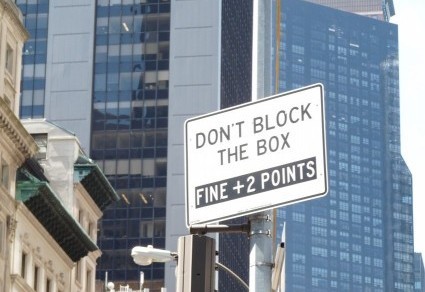New York signs make a valiant effort to boss people around. Valiant, but futile, as New Yorkers are not known for their unquestioning obedience. Yet the effort continues. Call it faith, if you’re an optimist, or insanity, if you’re not. Here’s an example of bossy New York, in the primary image I chose for this blog:

I often wonder whether non-New Yorkers understand this sign, which directs cars to stay out of the intersection (“the box”) when the traffic light turns red. New Yorkers decode it easily; they just choose to ignore it. Effective or not, this sign is one of my favorites, rivaled only by the classic “Don’t even think of parking here” that sadly has disappeared from the streets of New York. Not that drivers paid attention to that one either.
Recently I snapped photos of two lists of no-nos. Here’s one from a city bus:

Except for the first (littering), riders mostly obey the other prohibitions on this list. I don’t credit the sign, though, because in this day and age, hardly anyone assumes that smoking is allowed on public transit. Spitting is rare because of the gross-out factor. The last prohibition seems to be a leftover from the boom-box era, when teenagers lugging thirty pounds of technology blasted thumpingly loud music into their fellow riders’ ears. Even then, those devices were more often playing CD tracks, not radio broadcasts.
The next sign was posted by the management of an apartment building:

When I saw this sign, no one was around, so no one was noncompliant. So is this an effective sign? In my view, no, because of its content. Maybe a couple of kids gave up ball-playing, but that’s probably because they’d been scolded by someone who didn’t want to listen to the thump of a tennis ball or a Spaldeen (a pink ball essential to stickball, a NY street sport that no one plays anymore because of all the Uber vans clogging the road). Nor does the sign stop “loitering.” That activity disappears naturally because if you stand in one spot, a preoccupied pedestrian is likely to knock you over. Side point: Why specify “sitting in front of building”? Perhaps you’re allowed to sit next to or behind the structure? Or on top of it, if you can get past the doorman? I agree with the ban on peddling. It’s a well known fact that one sidewalk cart, unopposed, spawns ten more each day, each of which in turn gives rise to ten more, leading to . . . well, you can imagine. But peddlng is, in my opinion, less of a problem for this building than pedaling — bikes criss-crossing the sidewalk and terrifying everyone moving on actual feet.
But carriages? True, strollers increasingly resemble Hummers. I’ve been kneecapped by more than a few baby carriages myself. But seriously — how can you tell parents that their baby’s primary mode of transportation is not welcome? You may have noticed that the list ends with “under penalty of law.” Illegal baby carriages. Who knew? Unless they’re referring to a Jane Austen sort of carriage? Or the horse-drawn ones that circle Central Park? Not likely.
It seems to me that New Yorkers, with their ingenuity and preference for hanging out (loitering?) on the cutting edge, should be able to come up with a better “don’t” list. Mine isn’t complete, but so far I’ve got cell-phone blathering in crowded areas (especially when it involves relationships, recent surgery, or job complaints), texting while walking, and bicycling on the sidewalk. What’s on your list? Feel free to send it in. First prize is a boom box with an AM/FM connection, which you can use whenever you sit next to a “no radio playing” sign.


















